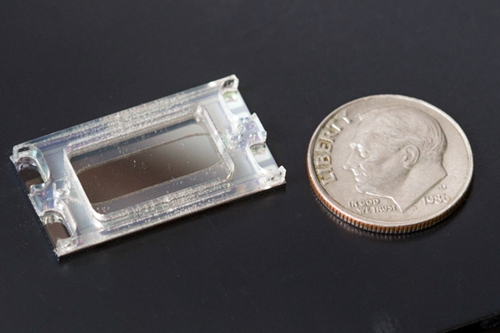23 November 2015. A team from University of California in San Diego used a miniature electronic chip to quickly separate nanoparticles for delivering drugs from blood plasma. The process, with a technology developed in the engineering lab of Michael Heller at UC-San Diego and licensed to a spin-off company from the university, is described in a recent article appearing in the journal Small (paid subscription required).
Heller and colleagues are seeking an easier way to recover nanoparticles from blood for evaluation, which can help clinicians determine the effectiveness of drugs delivered with this method. Nanoscale particles — where 1 nanometer equals 1 billionth of a meter — are gaining more interest as a way to deliver therapies. Nanoparticles in various forms and chemistries flow through the blood and are delivered to and accumulate at the site of disease or injury, usually in smaller doses, and thus with fewer side effects.
Isolating therapeutic nanoparticles today, however, is a difficult and complex process, because of the particles’ tiny size and low concentration in blood. Today’s techniques, say the authors, generally require adding a concentrated sugar solution and separation with a centrifuge, or adding an agent that attaches to the particles, all of which can affect the particles and make them difficult to evaluate.
“We were interested in a fast and easy way to take these nanoparticles out of plasma,” says Heller in a university statement, “so we could find out what’s going on at their surfaces and redesign them to work more effectively in blood.”
Researchers — from the university’s engineering, medical, and neuroscience faculties — employed a technology developed earlier in Heller’s lab for separating the particles from plasma, the liquid part of blood. That technology adapts an electrokinetic process requiring a tiny sample of blood, 250 microliters, exposed to a lab-on-a-chip device creating an electric field. The oscillating field polarizes the particles of interest, pulling them out of the sample and collecting them on the chip’s electrodes.
The team reports the technique processed plasma samples with several types and materials of nanoparticles, including nanoscale lipsomes, tiny bubbles made with the same lipid membranes found in cells, and used more frequently for drug delivery. The technique, say the researchers, takes about seven minutes and requires no special sample preparation.
Once separated from the plasma, drug-delivery nanoparticles can them be inspected with an electron microscope for changes in surface or structure. The team says the technique can be used to test a patient’s blood in advance for reactions to nanoparticle drug delivery, as well as inspections after a nanoparticle drug is delivered.
The analytical chip used in this study was developed by Raj Krishnan, then a doctoral student in Heller’s lab, who started the company Biological Dynamics that licensed the technology from UC-San Diego. Biological Dynamics, founded in 2008 by Krishnan and others, applies the technology to diagnostics for a range of conditions including cancer, infectious disease, cardiovascular disease, and trauma.
The company’s lead product is a liquid biopsy for cancer designed to extract cell-free DNA and other biomarkers for tracking a cancer patient’s response to treatment, which quickly isolates and quantifies the biomarkers with a small sample of blood. The company says the product, known as TR(ACE) is being evaluated in clinical settings.
Read more:
- Genomic, Patient Data Integrated for Precision Medicine
- Nanotech Sensors Devised for RNA Cancer Detection
- Exosome Therapy Start-Up Launches, Raises $80M
- Penn, Epic Sciences Partner on Liquid Biopsies
- Study Shows Blood Test Finds Early Pancreatic Cancer
* * *


 RSS - Posts
RSS - Posts
You must be logged in to post a comment.